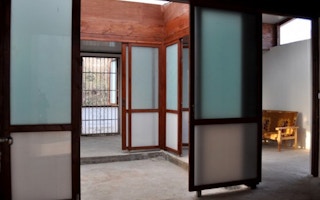Launched in 2009, MIT’s “1K House” project challenges designers to come up with affordable, sustainable housing solutions that can improve conditions for the billions of people in the world living on less that $1 per day. The “Pinwheel House” designed by MIT graduate student Ying chee Chui is the first prototype.
The 1K House concept was initiated by Tony Ciochetti, the Thomas G. Eastman Chairman at MIT’s Center for Real Estate, after seeing a family of four emerge from a tiny mud hut while he was traveling through rural India.
“There is a huge proportion of the world’s population that has pressing housing needs,” says Ciochetti. “Can you build affordable, sustainable shelter for such a large population?”
Ying chee Chui’s “Pinwheel House” is the first prototype to be constructed and is located in Mianyang, in the Sichuan Province, China. The design incorporates a modular layout with hollow brick walls, steel bars for reinforcement, wooden box beams, a central courtyard space and it’s also built to withstand a magnitude 8.0 earthquake.
“The construction is easy enough, because if you know how to build a single module, you can build the whole house,” says Chui.
Chui came out a little over the long-term goal of building a $1000 house, with the total cost coming to US$5,925. Not bad considering it’s tough to buy a good second hand car for that price! A larger building than was originally designed was a factor in the cost - the whole house came to about 800 square feet, rather than 500 square feet. Chui is confident that the smaller module could easily be built for US$4000 or even cheaper if a large number of houses were built at the same time.
MIT’s next design project starts in coming months with the aim of creating a series of US$10K home designs. The new designs will focus on creating cheap homes following a natural disaster situation, such as the earthquake and tsunami that struck northern Japan in March.
“It’s part of the responsibility of an architect, to create these spaces for people to live,” Chui says. “It’s from the heart.”










